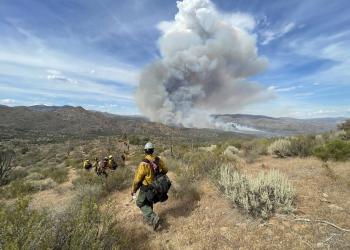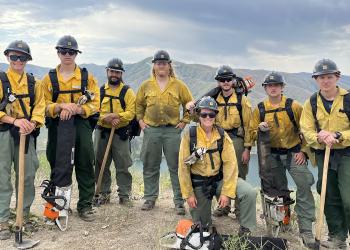Fire
Wildland fires are a force of nature that can be nearly as impossible to prevent, and as difficult to control, as hurricanes, tornadoes, and floods.
Wildland fire can be beneficial or destructive. In the right place at the right time, wildland fire can create many environmental benefits, such as reducing dry grasses, brush, and trees that can fuel large and severe wildfires and improving wildlife habitat. In the wrong place at the wrong time, wildfires can wreak havoc by threatening lives, homes, communities, along with natural and cultural resources.
The Forest Service has been managing wildland fire on National Forests and Grasslands for more than 100 years. However, the Forest Service doesn’t do it alone. Instead, the agency works closely with other federal, tribal, state, and local partners. And homeowners can do their part with creating defensible space around their property.
This is more important than ever, because over the last few decades the wildland fire management environment has profoundly changed. Longer fire seasons that attain bigger fires and more acres burned on average each year; more extreme fire behavior; and wildfire suppression operations in the wildland urban interface (WUI) have become the norm.
To address these challenges, the Forest Service and its other federal, tribal, state, and local partners have developed and are implementing a National Cohesive Wildland Fire Management Strategy. that has three key components: resilient landscapes, fire adapted communities, and safe and effective wildfire response.
Prescribed Fire

Prescribed burns are sometimes conducted to remove an excess of vegetation in areas that could become a large, intense wildland fire if ignited unintentionally, either by lightning or people.
These prescribed fires are conducted within a “prescription” that defines the location, fuel moisture levels, air temperatures, wind conditions, and relative humidity levels that are appropriate for each project.
Wildfire Crisis Strategy

In January 2022, the Forst Service launched a robust effort to address the crisis of wildfire in the places where it poses the most immediate threats to communities, critical infrastructure, and natural resources. The strategy combines a downpayment of congressional funding with years of scientific research and planning into a national effort that that will dramatically increase the pace and scale of forest health treatments. The Boise National Forest is working with states, Tribes and other partners to address wildfire risks to critical infrastructure, protect communities, and make forests more resilient.
Fire Hire

What to fulfill your passion by getting into a Boise National Forest fire job? This field captures a broad field of work with not just firefighters like hand & engine crews, but also fire prevention techs, dispatchers, lookouts and more!


